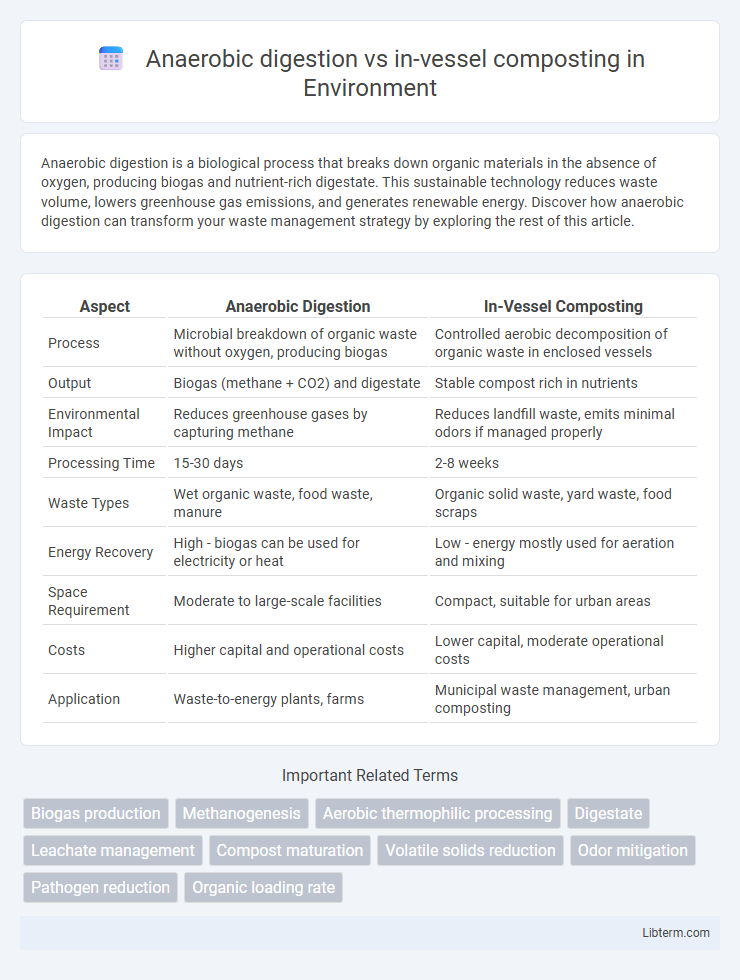Anaerobic digestion is a biological process that breaks down organic materials in the absence of oxygen, producing biogas and nutrient-rich digestate. This sustainable technology reduces waste volume, lowers greenhouse gas emissions, and generates renewable energy. Discover how anaerobic digestion can transform your waste management strategy by exploring the rest of this article.
Table of Comparison
| Aspect | Anaerobic Digestion | In-Vessel Composting |
|---|---|---|
| Process | Microbial breakdown of organic waste without oxygen, producing biogas | Controlled aerobic decomposition of organic waste in enclosed vessels |
| Output | Biogas (methane + CO2) and digestate | Stable compost rich in nutrients |
| Environmental Impact | Reduces greenhouse gases by capturing methane | Reduces landfill waste, emits minimal odors if managed properly |
| Processing Time | 15-30 days | 2-8 weeks |
| Waste Types | Wet organic waste, food waste, manure | Organic solid waste, yard waste, food scraps |
| Energy Recovery | High - biogas can be used for electricity or heat | Low - energy mostly used for aeration and mixing |
| Space Requirement | Moderate to large-scale facilities | Compact, suitable for urban areas |
| Costs | Higher capital and operational costs | Lower capital, moderate operational costs |
| Application | Waste-to-energy plants, farms | Municipal waste management, urban composting |
Introduction to Organic Waste Treatment Technologies
Anaerobic digestion and in-vessel composting are advanced organic waste treatment technologies designed to reduce environmental impact and recover resources. Anaerobic digestion involves microbial breakdown of organic material in an oxygen-free environment, producing biogas and nutrient-rich digestate. In-vessel composting accelerates aerobic decomposition within a controlled, enclosed system, generating stabilized compost suitable for soil amendment.
Understanding Anaerobic Digestion
Anaerobic digestion is a microbial process that breaks down organic waste in the absence of oxygen, producing biogas composed mainly of methane and carbon dioxide, which can be used as renewable energy. This method reduces landfill waste volume, lowers greenhouse gas emissions, and generates nutrient-rich digestate that serves as a valuable fertilizer. Compared to in-vessel composting, anaerobic digestion offers the dual benefits of energy recovery and waste stabilization, making it an efficient solution for organic waste management.
Overview of In-Vessel Composting
In-vessel composting is a controlled aerobic process that decomposes organic waste within enclosed containers, enhancing temperature and moisture regulation to accelerate microbial activity. This method effectively minimizes odors and pests while producing nutrient-rich compost suitable for agriculture and landscaping. Compared to anaerobic digestion, in-vessel composting requires less complex technology and shorter processing times but does not capture biogas for energy production.
Feedstock Suitability and Requirements
Anaerobic digestion is well-suited for wet, organic-rich feedstocks like food waste, manure, and sewage sludge that have high moisture content and biodegradability. In-vessel composting accommodates a broader range of feedstocks, including yard trimmings, food scraps, and agricultural residues, requiring balanced carbon-to-nitrogen ratios and adequate aeration for effective composting. Feedstock particle size and consistency are critical in both processes, with anaerobic digestion favoring homogenized, pumpable substrates, while in-vessel composting handles varied materials through controlled mixing and aeration.
Process Workflow and Technology
Anaerobic digestion involves breaking down organic material in an oxygen-free environment using microorganisms, producing biogas and digestate through a sealed, temperature-controlled reactor system. In-vessel composting accelerates aerobic decomposition by maintaining optimal oxygen levels, temperature, and moisture within enclosed vessels, resulting in nutrient-rich compost. Both methods utilize controlled environmental conditions and specialized technology to enhance organic waste conversion but differ in microbial processes and end products.
Environmental Impact Comparison
Anaerobic digestion reduces greenhouse gas emissions by capturing methane for biogas energy, significantly lowering the carbon footprint compared to in-vessel composting, which primarily emits carbon dioxide during organic breakdown. In-vessel composting accelerates organic matter decomposition in a controlled environment, minimizing odor and leachate but lacks energy recovery benefits found in anaerobic digestion systems. Both methods mitigate landfill waste, but anaerobic digestion offers superior renewable energy production and a lower environmental impact through effective methane management.
Energy Production and Resource Recovery
Anaerobic digestion excels in energy production by breaking down organic waste to generate biogas, primarily methane, which can be used for electricity, heat, or as vehicle fuel, offering a high-efficiency renewable energy source. In-vessel composting focuses more on resource recovery by rapidly converting organic materials into nutrient-rich compost, enhancing soil health and reducing the need for chemical fertilizers. While anaerobic digestion captures energy from waste, in-vessel composting prioritizes the recovery of valuable organic nutrients, making both methods complementary in sustainable waste management.
Operational Costs and Economic Considerations
Anaerobic digestion typically involves higher initial investment due to complex infrastructure requirements but offers ongoing revenue streams through biogas production and potential energy sales, reducing long-term operational costs. In-vessel composting generally has lower startup costs but may incur higher operational expenses related to labor, temperature control, and odor management without generating direct revenue. Economic considerations favor anaerobic digestion for facilities aiming for renewable energy integration and cost recovery, while in-vessel composting suits smaller-scale operations prioritizing waste volume reduction and soil amendment production.
End Products and Their Applications
Anaerobic digestion produces biogas, primarily methane and carbon dioxide, which serves as a renewable energy source, alongside nutrient-rich digestate used as a fertilizer or soil conditioner. In-vessel composting generates stabilized compost, rich in organic matter and humus, improving soil structure and fertility when applied as a soil amendment. Both processes create valuable end products, but anaerobic digestion emphasizes energy recovery, while in-vessel composting focuses on organic matter recycling and soil health enhancement.
Choosing the Right Solution for Your Needs
Anaerobic digestion efficiently converts organic waste into biogas and nutrient-rich digestate, making it ideal for energy generation and reducing greenhouse gas emissions. In-vessel composting accelerates aerobic decomposition, producing high-quality compost suitable for soil enhancement, especially when temperature and odor control are priorities. Assess feedstock characteristics, desired end-products, and available infrastructure to determine the best waste management technology for your specific environmental and operational goals.
Anaerobic digestion Infographic

 libterm.com
libterm.com